MEMS-VCSEL Swept-Wavelength Laser Sources
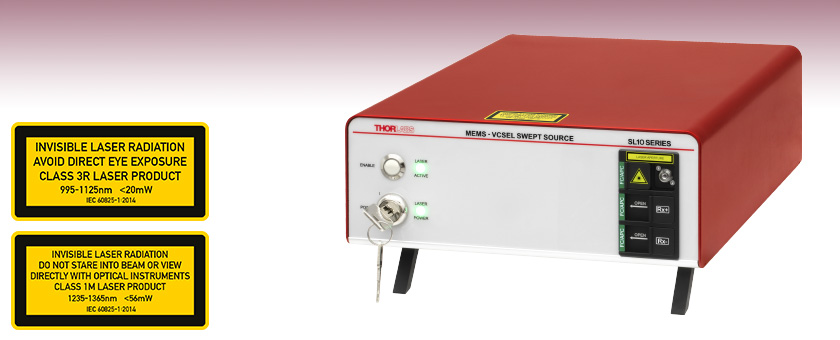
SL101081
1060 nm MEMS-VCSEL Swept Source
100 kHz Sweep Rate, 24 mm MZI Delay
with Integrated Balanced Detector
- Available with 1060 nm or 1300 nm Center Wavelength
- Sweep Rates from 50 kHz to 400 kHz
- Over 100 mm Coherence Length
- Single Mode, Mode-Hop-Free Operation
- Linear Sweep Trajectory

Please Wait

OCT Applications Team Based in Lübeck, Germany
We are happy to assist with purchasing or information requests. You can easily contact us directly at oct@thorlabs.com or via our online request form; a Thorlabs customer representative will contact you shortly.
| Common Specificationsa | |
|---|---|
| Wavelength Sweep Range | 100 nm |
| Coherence Length | ≥100 mm |
| Ripple Noise Suppression | ≥50 dB |
| Relative Intensity Noise (RIN) | ≤2% |
Features
- Benchtop Swept-Wavelength Laser Sources
- 1060 nm or 1300 nm Center Wavelength
- 100 nm Mode-Hop-Free Sweep Range
- User-Adjustable k-Clock Signal Delay
- Trigger and k-Clock Signal Output Provided
Thorlabs' Swept-Wavelength Laser Sources are available with 1060 nm or 1300 nm center wavelengths and operate mode-hop-free over the full 100 nm wavelength range. They have record-breaking coherence lengths of over 100 mm. Options are available for sweep rates from 50 kHz to 400 kHz and MZI delays from 8 mm to 72 mm. A Thorlabs balanced detector can also be integrated into the benchtop source. If the options desired are not covered by the configurations available below, please contact our MEMS-VCSEL Source Team for custom configurations.
These single mode benchtop laser sources are designed primarily for high-speed and long-range optical coherence tomography (OCT) systems requiring superior sensitivity, as well as being well-suited for metrology, spectroscopy, and other applications. The sources are based on a patented microelectromechanical system (MEMS) tunable vertical cavity surface emitting laser (VCSEL) and include an active power control that maintains constant output power over the lifetime of the laser. The FC/APC fiber-coupled laser output port can be closed by sliding the door to the right when not in use, serving as both a beam block and a dust cover.
All drive electronics and trigger signals needed to easily integrate our MEMS-VCSEL laser into custom swept-source OCT systems are provided. An output digital “k-clock” signal generated by the integrated Mach-Zehnder interferometer (MZI) and drive electronics can be used as a data acquisition sampling clock, with no further resampling in k-space required. The k-clock signal delay can be adjusted up to ±8 ns, and the output power of the laser up to a maximum of ±5% by the user.
OCT Imaging with a MEMS-VCSEL Swept Source
OCT systems built using our MEMS-VCSEL sources provide high-quality images and are capable of significant imaging depths. The OCT cross-sectional image of the anterior eye shown below (left) was obtained using the equivalent of an SL131090 integrated into a Vega OCT system. The laser was swept over a wavelength range of 100 nm and had a 100 kHz sweep rate. This Vega system had a 44 mm MZI delay, an axial resolution in air better than 16 μm, and was capable of high-resolution imaging to a maximum depth of 11 mm. The OCT measurement signal was digitized with a 500 MSPS A/D converter, and the system provided 100 000 A-scans/s. Details of this system and its performance can be found here.
Point spread function (PSF) is a measurement of the optical performance of an imaging system, and narrower peaks indicate better performance. The PSF shown below (center) was obtained for the same Vega system as was used for the image to the left, but is typical of any OCT system using one of our swept-source lasers. For example, a system with an integrated SL101081 is shown to the right with similar performance, but with a maximum imaging depth of 6 mm.
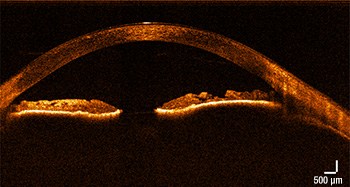
Click to Enlarge
OCT Cross-Sectional Image of the Anterior Eye, from an OCT System
with Integrated SL13 MEMS-VCSEL Swept Source
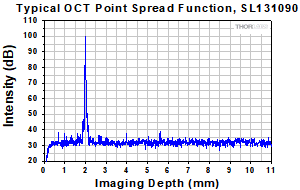
Click to Enlarge
Click Here to Download the Raw Data
PSF Obtained for an OCT System with Integrated SL13 Series
MEMS-VCSEL Swept Source, Using Integrated k-Clock
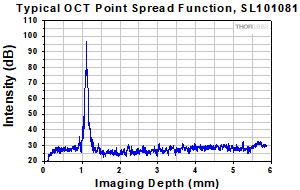
Click to Enlarge
Click Here to Download the Raw Data
PSF Obtained for an OCT System with Integrated SL10 Series
MEMS-VCSEL Swept Source, Using Integrated k-Clock
1060 nm MEMS-VCSEL Swept Sources
| Item #s | SL100060, SL100061 | SL101080, SL101081 | SL101060, SL101061 | SL102080, SL102081 | SL104070, SL104071 | |
|---|---|---|---|---|---|---|
| Sweep Rate | fMEMS | 60 kHz | 100 kHz | 100 kHz | 200 kHz | 400 kHz |
| Duty Cycle (Unidirectional Sweep) | DBOA | >60% | >60% | >60% | >50% | >50% |
| MZI Delay | ΔMZI | 48 mm | 24 mm | 48 mm | 24 mm | 8 mm |
| k-Clock Minimum Pointsa | Nmin | 4096 | 2048 | 4096 | 2048 | 640 |
| k-Clock Max Frequency (Typical) | fclock | 500 MHz | 500 MHz | 900 MHz | 900 MHz | 900 MHz |
| Imaging Depth Range (Approximate) | Δzmax | 12 mm | 6 mm | 12 mm | 6 mm | 2 mm |
| Optical Specifications for 1060 nm Swept Sources | ||||
|---|---|---|---|---|
| Parameter | Symbol | Minimum | Typical | Maximum |
| Center Wavelength | λc | 1040 nm | 1060 nm | 1080 nm |
| Wavelength Sweep Rangea (-10 dB) | Δλsweep | 95 nm | 100 nm | - |
| Average Output Power | Po | 15 mW | 17.5 mW | 20 mW |
| Coherence Length | LCoh | 100 mm | >1 m | - |
| Spectral Ripple Noise Suppression | dP | - | ≥50 dB | - |
| Relative Intensity Noise | RINORTHO | - | - | 2% |
| λ Trigger Wavelengthb | - | 1045 nm | 1050 nm | 1055 nm |
| Output Fiber Numerical Aperture | NA | - | 0.105 | - |
| Laser Classification (IEC 60825-1:2014) | - | 3R | ||
1300 nm MEMS-VCSEL Swept Sources
| Item #s | SL130160, SL130161 | SL131090, SL131091 | SL131160, SL131161 | SL132120, SL132121 | SL134050, SL134051 | |
|---|---|---|---|---|---|---|
| Sweep Rate | fMEMS | 50 kHz | 100 kHz | 100 kHz | 200 kHz | 400 kHz |
| Duty Cycle (Unidirectional Sweep) | DBOA | >60% | >60% | >60% | >50% | >50% |
| MZI Delay | ΔMZI | 72 mm | 44 mm | 72 mm | 32 mm | 12 mm |
| k-Clock Minimum Pointsa | Nmin | 4096 | 2496 | 4096 | 1792 | 640 |
| k-Clock Max Frequency (Typical) | fclock | 500 MHz | 500 MHz | 900 MHz | 900 MHz | 900 MHz |
| Imaging Depth Range (Approximate) | Δzmax | 18 mm | 11 mm | 18 mm | 8 mm | 3 mm |
| Optical Specifications for 1300 nm Swept Sources | ||||
|---|---|---|---|---|
| Optical Specifications | Symbol | Minimum | Typical | Maximum |
| Center Wavelength | λc | 1280 nm | 1300 nm | 1320 nm |
| Wavelength Sweep Rangea (-10 dB) | Δλsweep | 95 nm | 100 nm | - |
| Average Output Power | Po | 20 mW | 25 mW | 30 mW |
| Coherence Length | LCoh | 100 mm | >1 m | - |
| Spectral Ripple Noise Suppression | dP | - | ≥50 dB | - |
| Relative Intensity Noise | RINORTHO | - | - | 2% |
| λ Trigger Wavelength | - | 1295 nm | 1300 nm | 1305 nm |
| Output Fiber Numerical Aperture | NA | - | 0.09 | - |
| Laser Classification (IEC 60825-1:2014) | - | 1M | ||
Common Specifications, All MEMS-VCSEL Swept Sources
| Physical Specifications | ||
|---|---|---|
| Parameter | Minimum | Maximum |
| Main AC Voltage | 100 VAC | 250 VAC |
| Power Consumption | - | 45 W |
| Line Frequency | 50 Hz | 60 Hz |
| Operating Temperature | 10 °C | 35 °C |
| Storage Temperature | 0 °C | 50 °C |
| Relative Humidity | - | 85%, Non-Condensing |
| Electrical Performance Specifications | |||
|---|---|---|---|
| Parameter | Minimum | Typical | Maximum |
| k-Clock "Dummy Clock" Frequency | - | 250 | MHz |
| k-Clock Amplitude | - | - | 1.0 Vpp |
| Sweep Trigger Pulse Width (100 kHz Sweep Rate) | - | 350 ns | - |
| Sweep Trigger Rise Time | - | 0.6 ns | - |
| Sweep Trigger Output Type | LVTTL | ||
| λ Trigger Pulse Width (100 kHz Sweep Rate) | 25 ns | 50 ns | 75 ns |
| λ Trigger Rise Time | - | 0.6 ns | - |
| λ Trigger Output Type | LVTTL | ||
| Laser Controller Start Delay | 5 s | - | 15 s |
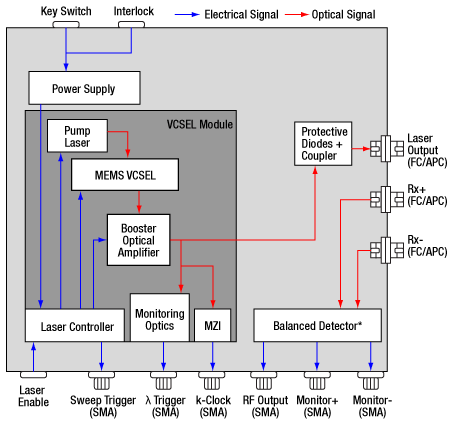
Click to Enlarge
Schematic of MEMS-VCSEL Swept Source with Balanced Detection
Thorlabs' MEMS-VCSEL benchtop systems incorporate all the necessary drive electronics, temperature controllers, trigger signals, and optical isolators for easy operation and integration into any swept-source OCT system. Additionally, these benchtop laser sources utilize a specially designed Mach-Zehnder Interferometer (MZI) "k-clock" that provides a digital output signal for triggering data acquisition.
The figure to the right shows a schematic of the MEMS-VCSEL benchtop system. These systems consist of a MEMS-VCSEL cavity, a booster optical amplifier (BOA), a fiber-optic monitoring network, and signal generation circuits. The optical output of the MEMS-VCSEL cavity module is connected to the optical input of the BOA. Integrated optical isolators in the benchtop laser sources eliminate the need for additional isolators external to the laser. Three electrical output signals, shown at the bottom of the schematic, can be used via SMA connectors to synchronize a data acquisition system to the swept optical output.
Sweep Trigger
The Sweep Trigger provides an electronically generated line trigger at the beginning of the sweep. The rising edge of the pulse is synchronized to the beginning of the sweep. The sweep trigger is generally used as a trigger for data acquisition systems. The signal is series terminated with 50 Ω.
Wavelength Trigger (λ Trigger)
"λ Trigger" is an optically generated line trigger that indicates when the laser output has crossed a certain wavelength. This fiber-Bragg-grating-based optical trigger usually represents the middle of the sweep. Due to its higher wavelength stability, it is used as an alternative to the sweep trigger and can be used for phase-sensitive applications where sweep-to-sweep stability is required. The signal is series terminated with 50 Ω.
k-Clock
The k-clock signal is used as a data acquisition sampling clock, internally generated from an MZI. The digital output from the MZI "k-Clock" is linear in wavenumber, allowing optically generated signals to be sampled linearly in "k-space," rather than in the time domain. Electrically, the signal is an AC-coupled digital clock with an amplitude between 0.7 and 1.0 Vpp. During the back-scan, the k-clock circuit will switch over to a "dummy clock", which operates at a fixed frequency and is not correlated to the optical subsystem. The dummy clock runs at approximately 250 MHz.
Balanced Detector (Not Included with SL1xxxx0 Sources)
The balanced detector (included with item #s that end in 1) consists of two well-matched photodiodes and an ultra-low-noise, high-speed transimpedance amplifier. This acts as a balanced receiver by subtracting Rx+ from Rx-, resulting in the cancellation of common mode noise. This produces an RF Output voltage that has small changes in the signal path extracted from the interfering noise floor. The optical input power level to each photodiode can be monitored through the Monitor+ and Monitor- fast monitor outputs.
*The balanced detector and its associated connections will not be present on item #s ending in 0.
Front and Back Panels (without Balanced Detector, SL1xxxx0 Sources)
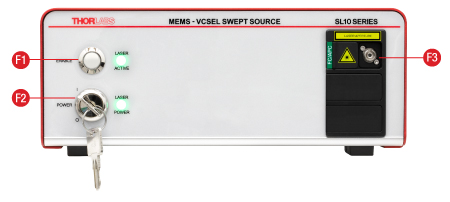
Click to Enlarge
Front Panel of MEMS-VCSEL Source
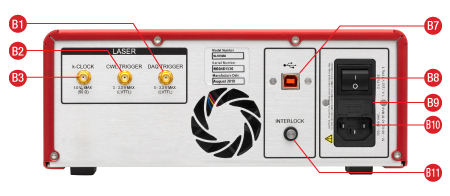
Click to Enlarge
Back Panel of MEMS-VCSEL Source
Front and Back Panels (with Balanced Detector, SL1xxxx1 Sources)
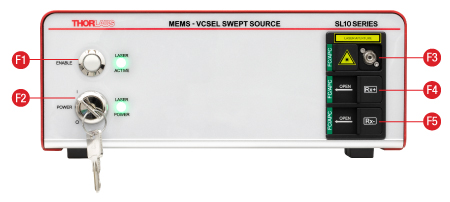
Click to Enlarge
Front Panel of MEMS-VCSEL Source with Balanced Detector
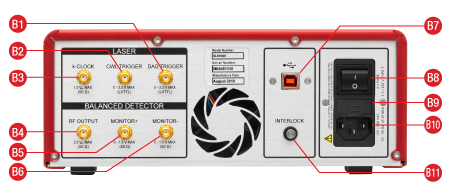
Click to Enlarge
Back Panel of MEMS-VCSEL Source with Balanced Detector
| Front Panel | |
|---|---|
| Callout | Description |
| F1 | Laser Enable Button |
| F2 | Laser Power Key Switch |
| F3a | Optical Output, FC/APC Connector |
| F4a | Rx+ Optical Input, FC/APC Connector |
| F5a | Rx- Optical Input, FC/APC Connector |
| Back Panel | |
|---|---|
| Callout | Description |
| B1 | Data Acquisition (DAQ) Trigger Signal |
| B2 | Center Wavelength (CWL) Trigger Signal |
| B3 | k-Clock Signal |
| B4 | Balanced Detector RF Output Signal |
| B5 | Balanced Detector Monitor+ |
| B6 | Balanced Detector Monitor- |
| B7 | USB Type B Port |
| B8 | Main Power Switch |
| B9 | Fuse Holder |
| B10 | AC Power Cord Connector |
| B11 | Interlock Connector |
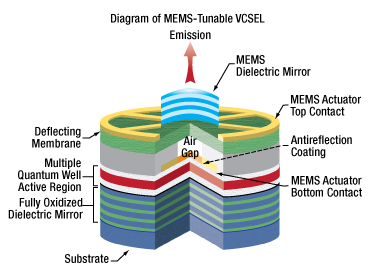
Click to Enlarge
Figure 1: Praevium's MEMS-Tunable VCSEL is an innovative design that offers high-speed and broadband emission with long coherence length. This is an ideal combination for an OCT swept laser source.
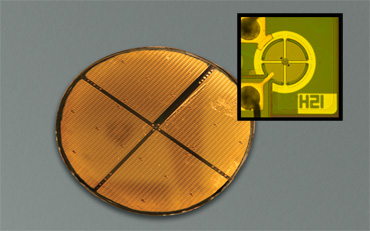
Click to Enlarge
Figure 2: MEMS-tunable VCSELs can be densely packed on a single wafer to increase the potential yield. The inset shows a single MEMS-tunable VCSEL device after fabrication. The overall size of the MEMS-tunable VCSEL is approximately 600 µm x 600 µm square.
VCSEL Overview
Vertical Cavity Surface Emitting Lasers (VCSELs) are semiconductor-based devices that emit light perpendicular to the chip surface, as shown in Figure 1. VCSELs were originally developed as low-cost, low-power alternatives to edge-emitting diodes, mainly for high-volume datacom applications. Quickly thereafter, the advantages of VCSELs became evident, leading them to being preferred light sources over edge-emitters in many applications. Compared to edge-emitting sources, VCSELs offer superior output beam quality and single mode operation.
MEMS-tunable VCSELs utilize microelectromechanical mirror systems (MEMS) to vary the cavity length of the laser, thereby tuning the output wavelength. MEMS-tunable VCSELs have existed for several years; however, the limited tuning range and output power of these devices have precluded them from being used in OCT applications. Praevium Research, in cooperation with Thorlabs and MIT, has since developed a MEMS-tunable VSCEL design that overcomes these previous limitations.
In order for a MEMS-tunable VCSEL to be successful for applications in OCT, it needs to meet certain standards:
- Rapid Sweep Speed
- Broad Tuning Range
- Long Coherence Length
- High Laser Output Power
Rapid Sweep Speed
Applications using OCT demand high-speed imaging without sacrificing imaging quality. Fast imaging rates allow better time resolution, dense collection of 3D datasets, and decreased laser exposure times to the sample.
Currently, there exist a few swept-source lasers that offer high-speed scanning. Fourier domain mode-locked lasers, for example, achieve extremely high imaging speeds but require the use of very long fiber optic delays in the laser cavity and can only operate in wavelength ranges where the fiber loss is low. Of the commercially available high-speed swept lasers, many operate with multiple longitudinal modes or have long cavity lengths, which limit coherence length or tuning speed, respectively.
The low mass of the MEMS-tuning mirror in a MEMS-based tunable VCSEL and the short cavity length both contribute to its high-speed operation. The short cavity length also places only one mode in the gain spectrum, enabling single-mode continuous operation. We have recently measured greater than 500 kHz sweep rates using a MEMS-tunable VCSEL prototype, without using optical multiplexing to increase the sweep speed.
Broad Tuning Range
High-resolution imaging depends on the overall tuning bandwidth of the swept-source laser. Praevium boasts the broadest bandwidth MEMS-tunable VCSEL that has ever been developed. A unique design incorporating broadband, fully oxidized mirrors, as well as wideband gain regions and thin active regions, has currently resulted in greater than 100 nm of continuous mode-hop-free tuning, centered around 1300 nm. For details, please see Figure 3.
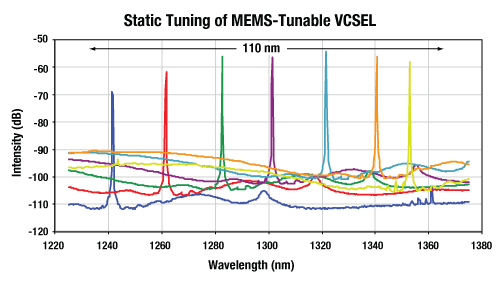
Click to Enlarge
Figure 3: MEMS-tunable VCSELs are capable of tuning over 100 nm. Here we show single-mode operation over a 110 nm spectral tuning range centered at 1300 nm.
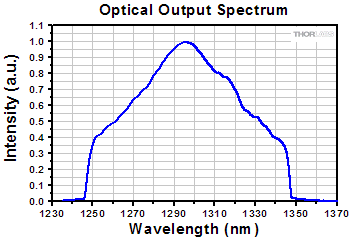
Click to Enlarge
Figure 4: Spectrum of MEMS-tunable VCSEL operating at 200 kHz, with a center wavelength around 1310 nm, and post amplification using a BOA.
Long Coherence Length
A significant limitation to most OCT systems is the depth of view (maximum imaging depth range). Especially in clinical applications, where sample thickness, patient motion, and sample location cannot be controlled, a long depth of view is advantageous. A long coherence length alone, however, is not enough. Image sensitivity needs to be virtually unaffected throughout the entire depth. Due to the micron-scale cavity length of the VCSEL and single mode, mode-hop-free operation, we have measured coherence lengths of greater than 100 mm from our MEMS-tunable VCSEL with nearly no signal degradation. Currently limited by detector bandwidth, we are confident that the MEMS-tunable VCSEL is able to achieve even longer imaging depths than have been measured to date. This remarkable depth of view will not only benefit the medical imaging community but also open doors to other applications such as large objective surface profiling, fast frequency domain reflectometry, and fast spectroscopic measurements with high spectral resolution.
High Output Power
Increased imaging speed often comes at the cost of decreased output power and/or optical power on the sample. One advantage of edge-emitting light sources over VCSELs is that they can emit greater output powers. As a general rule, most OCT imaging applications need a minimum of 20 mW of laser output power to maintain image quality when operating at faster scan rates. To reach this goal, the MEMS-tunable VCSEL is coupled with a booster optical amplifier (BOA) to achieve greater than 25 mW of power. An additional advantage of this post-amplification scheme is that the BOA reshapes the MEMS-VCSEL output spectrum such that it is much more uniform.
Additional Considerations and Manufacturing Capabilities
A special feature of the MEMS-tunable VCSEL is that it is scalable for different wavelengths. Through innovative combinations of gain materials and dielectric mirrors, a wide wavelength range in the visible or near infrared can be reached, enabling expansion of this new family of light sources.
As we further develop this light source, we look forward to finding new and exciting applications for its use. Please contact us to discuss how a MEMS-tunable VCSEL may advance your research.
Fabrication of a MEMS-Tunable VCSEL
Step 1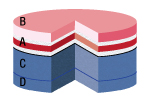
Click to Enlarge
The VCSEL wafer begins with a multiple quantum well (MQW) active region (A) that is grown on an InP substrate (B) and bonded to a GaAs-based mirror (C) grown on a GaAs substrate (D).
Step 2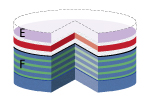
Click to Enlarge
The InP substrate is chemically etched down to a strategically located stop-etch layer (E). The GaAs-based mirror is oxidized to create a wideband dielectric mirror (F).
Step 3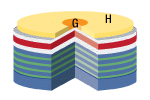
Click to Enlarge
After removal of the stop-etch layer, an AR coating (G) and annular MEMS bottom actuator contact (H) are deposited on top of the MQW active region.
Step 4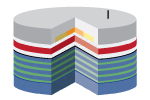
Click to Enlarge
A sacrificial layer (I) of a specifically designed thickness and composition is deposited.
Step 5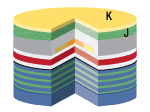
Click to Enlarge
A membrane layer (J) and annular top MEMS actuator contact (K) are deposited on top of the sacrificial layer.
Step 6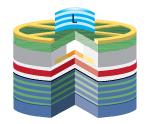
Click to Enlarge
Finally, a dielectric mirror (L) is deposited and patterned. The top MEMS contact is further patterned to complete creation of the actuator. The sacrificial layer is undercut to leave a suspended, moveable top mirror above the MQW structure, producing a VCSEL with a MEMS-based tuning element in a single device.
Laser Safety and Classification
Safe practices and proper usage of safety equipment should be taken into consideration when operating lasers. The eye is susceptible to injury, even from very low levels of laser light. Thorlabs offers a range of laser safety accessories that can be used to reduce the risk of accidents or injuries. Laser emission in the visible and near infrared spectral ranges has the greatest potential for retinal injury, as the cornea and lens are transparent to those wavelengths, and the lens can focus the laser energy onto the retina.
Safe Practices and Light Safety Accessories
- Laser safety eyewear must be worn whenever working with Class 3 or 4 lasers.
- Regardless of laser class, Thorlabs recommends the use of laser safety eyewear whenever working with laser beams with non-negligible powers, since metallic tools such as screwdrivers can accidentally redirect a beam.
- Laser goggles designed for specific wavelengths should be clearly available near laser setups to protect the wearer from unintentional laser reflections.
- Goggles are marked with the wavelength range over which protection is afforded and the minimum optical density within that range.
- Laser Safety Curtains and Laser Safety Fabric shield other parts of the lab from high energy lasers.
- Blackout Materials can prevent direct or reflected light from leaving the experimental setup area.
- Thorlabs' Enclosure Systems can be used to contain optical setups to isolate or minimize laser hazards.
- A fiber-pigtailed laser should always be turned off before connecting it to or disconnecting it from another fiber, especially when the laser is at power levels above 10 mW.
- All beams should be terminated at the edge of the table, and laboratory doors should be closed whenever a laser is in use.
- Do not place laser beams at eye level.
- Carry out experiments on an optical table such that all laser beams travel horizontally.
- Remove unnecessary reflective items such as reflective jewelry (e.g., rings, watches, etc.) while working near the beam path.
- Be aware that lenses and other optical devices may reflect a portion of the incident beam from the front or rear surface.
- Operate a laser at the minimum power necessary for any operation.
- If possible, reduce the output power of a laser during alignment procedures.
- Use beam shutters and filters to reduce the beam power.
- Post appropriate warning signs or labels near laser setups or rooms.
- Use a laser sign with a lightbox if operating Class 3R or 4 lasers (i.e., lasers requiring the use of a safety interlock).
- Do not use Laser Viewing Cards in place of a proper Beam Trap.
Laser Classification
Lasers are categorized into different classes according to their ability to cause eye and other damage. The International Electrotechnical Commission (IEC) is a global organization that prepares and publishes international standards for all electrical, electronic, and related technologies. The IEC document 60825-1 outlines the safety of laser products. A description of each class of laser is given below:
| Class | Description | Warning Label |
|---|---|---|
| 1 | This class of laser is safe under all conditions of normal use, including use with optical instruments for intrabeam viewing. Lasers in this class do not emit radiation at levels that may cause injury during normal operation, and therefore the maximum permissible exposure (MPE) cannot be exceeded. Class 1 lasers can also include enclosed, high-power lasers where exposure to the radiation is not possible without opening or shutting down the laser. |  |
| 1M | Class 1M lasers are safe except when used in conjunction with optical components such as telescopes and microscopes. Lasers belonging to this class emit large-diameter or divergent beams, and the MPE cannot normally be exceeded unless focusing or imaging optics are used to narrow the beam. However, if the beam is refocused, the hazard may be increased and the class may be changed accordingly. |  |
| 2 | Class 2 lasers, which are limited to 1 mW of visible continuous-wave radiation, are safe because the blink reflex will limit the exposure in the eye to 0.25 seconds. This category only applies to visible radiation (400 - 700 nm). |  |
| 2M | Because of the blink reflex, this class of laser is classified as safe as long as the beam is not viewed through optical instruments. This laser class also applies to larger-diameter or diverging laser beams. |  |
| 3R | Class 3R lasers produce visible and invisible light that is hazardous under direct and specular-reflection viewing conditions. Eye injuries may occur if you directly view the beam, especially when using optical instruments. Lasers in this class are considered safe as long as they are handled with restricted beam viewing. The MPE can be exceeded with this class of laser; however, this presents a low risk level to injury. Visible, continuous-wave lasers in this class are limited to 5 mW of output power. |  |
| 3B | Class 3B lasers are hazardous to the eye if exposed directly. Diffuse reflections are usually not harmful, but may be when using higher-power Class 3B lasers. Safe handling of devices in this class includes wearing protective eyewear where direct viewing of the laser beam may occur. Lasers of this class must be equipped with a key switch and a safety interlock; moreover, laser safety signs should be used, such that the laser cannot be used without the safety light turning on. Laser products with power output near the upper range of Class 3B may also cause skin burns. |  |
| 4 | This class of laser may cause damage to the skin, and also to the eye, even from the viewing of diffuse reflections. These hazards may also apply to indirect or non-specular reflections of the beam, even from apparently matte surfaces. Great care must be taken when handling these lasers. They also represent a fire risk, because they may ignite combustible material. Class 4 lasers must be equipped with a key switch and a safety interlock. |  |
| All class 2 lasers (and higher) must display, in addition to the corresponding sign above, this triangular warning sign. |  |
|
| Posted Comments: | |
Zenaida Preston
(posted 2024-02-08 22:18:50.17) Wow, fantastic blog format! How lengthy have you been blogging
for? you make running a blog glance easy. The full look of your site is fantastic,
as well as the content material! You can see similar: Funero.shop and here Funero.shop dpossin
(posted 2024-02-09 04:53:11.0) Dear Zenaida,
Thank you very much for you positive feedback. We really appreciate that. Robert Zawadzki
(posted 2023-11-30 16:02:52.167) Dear Sirs,
I am interested in purchasing Thorlabs VCSEL 1050nm, Multimode, and MZI
CWL: 1050 nm
Sweep rate: 400 x 1, 200 x 2(400), 400x2 (800) kHz
MZI (air): 12, 24, 12 mm
High Power
Could you please send me the information about the pricing and options?
Best
Robert Yangxi Li
(posted 2023-10-13 12:30:31.06) Since I need to model the sensitivity roll off of the OCT system, I need to know the instantaneous linewidth of the swept source SL131090. Where can I query this parameter? Or how to calibrate it fmortaheb
(posted 2023-10-17 06:29:34.0) Thank you very much for contacting Thorlabs. In fact, the roll-off can be neglected for our swept source MEMS VCSEL lasers. The instantaneous linewidth is in the order of ~0.5 - 1.0 MHz corresponding to an estimated coherence length of 225m in air as shown within the following publication:
https://opg.optica.org/jlt/abstract.cfm?uri=jlt-33-16-3461 JUNG DAHUN
(posted 2023-03-09 18:50:00.627) Dear thorlabs
I am writing to inquire about direction of laser swept of SL132121
We have a SL132121 laser, but we don't know the direction of the laser's sweep.
Is it swept from the short wavelength to the long wavelength?
Thank you for your time and assistance. I look forward to hearing back from you soon.
Best regards,
Dahun Jung user
(posted 2023-03-01 11:43:21.173) Hi, I'm interested in this laser source, but I'm wondering if the short-wavelength cutoff could be pushed down to shorter wavelengths by a little bit with a little customization. Would it be possible to order a version capable of tuning from, for example, 1210 nm to 1300 nm? The long-wavelength cutoff only needs to be around 1280 nm for my application - it's more important to have short-wavelength reach for me. Let me know if this might be possible.
Thanks
Jeff SHUNAN CHEN
(posted 2022-06-15 11:21:09.337) Can I apply for a trail version of model.SL130161 or SL130160, I want to do some experiment to prove the light source is suitable for the experiment. Looking forward to your reply. wskopalik
(posted 2022-06-16 04:24:40.0) Thank you for your interest in our products. We will contact you directly to learn more about your needs to select the right configuration. Tomasz Kardaś
(posted 2020-10-07 10:41:15.827) Dear Sir or Madame,
We are looking for a source for Optical Frequency Domain Reflectometry near 1030 nm. Your sources seem perfect, however, they are much to fast for this technique. We look for something with 1 - 100 Hz sweep rate. Can you recommend any solution? nreusch
(posted 2020-10-09 06:14:39.0) Thank you for your feedback. We will contact you directly to discuss your application and possible solutions. nyonuimon
(posted 2018-09-04 18:57:59.367) Hello, This is Yeon Hee Chang
I am researcher of DGIST, South Korea.
I am very interested in the laser source, SL132120 - MEMS-VCSEL Swept Source, 1300 nm, 200 kHz.
I want to get a formal quotation of this product.
Is it available?
Please send the quotation to my e-mail.
Thank you :)
Best regards
From Yeon Hee Chang llamb
(posted 2018-09-05 08:17:04.0) Hello Yeon. For a formal quote or other questions on our MEMS-VCSEL Swept-Wavelength Laser Source, you may email OCT@thorlabs.com. We will have a representative reach out to you by email in this case. thomas.juhasz
(posted 2018-09-03 14:29:07.34) Hello,
I have a very basic question for the MEMS-VCSEL Swept-Wavelength Laser Source: has the source a static mode, where the wavelength is kept constant, or is the wavelength swept continuously? If there is a static mode, what is the wavelength accuracy and spectral linewidth for different wavelengths within the tuning range?
Additionally, the output power range from min 20 to max 50mW seems rahther large. Is a preselection with respect to the output power possible?
Thanks and best regards
Thomas YLohia
(posted 2018-09-24 11:00:16.0) Hello Thomas, thank you for contacting Thorlabs. The wavelength will be swept continuously for the entire range -- unfortunately, there is no static mode and there is no preselection with respect to output power. Our OCT team (oct@thorlabs.com) will reach out to you directly to discuss your application in greater detail. |

| Item # | Sweep Rate | Duty Cyclea | MZI Delay | k-Clock Max Frequency (Typical) |
OCT Imaging Depth Rangeb |
Balanced Detectorc |
|---|---|---|---|---|---|---|
| SL100060 | 60 kHz | >60% | 48 mm | 500 MHz | 12 mm | None |
| SL100061 | PDB471C-AC | |||||
| SL101080 | 100 kHz | >60% | 24 mm | 500 MHz | 6 mm | None |
| SL101081 | PDB471C-AC | |||||
| SL101060 | 100 kHz | >60% | 48 mm | 900 MHz | 12 mm | None |
| SL101061 | PDB481C-AC | |||||
| SL102080 | 200 kHz | >50% | 24 mm | 900 MHz | 6 mm | None |
| SL102081 | PDB481C-AC | |||||
| SL104070 | 400 kHz | >50% | 8 mm | 900 MHz | 2 mm | None |
| SL104071 | PDB481C-AC |

| Item # | Sweep Rate | Duty Cyclea | MZI Delay | k-Clock Max Frequency (Typical) |
OCT Imaging Depth Rangeb |
Balanced Detectorc |
|---|---|---|---|---|---|---|
| SL130160 | 50 kHz | >60% | 72 mm | 500 MHz | 18 mm | None |
| SL130161 | PDB470C-AC | |||||
| SL131090 | 100 kHz | >60% | 44 mm | 500 MHz | 11 mm | None |
| SL131091 | PDB470C-AC | |||||
| SL131160 | 100 kHz | >60% | 72 mm | 900 MHz | 18 mm | None |
| SL131161 | PDB480C-AC | |||||
| SL132120 | 200 kHz | >50% | 32 mm | 900 MHz | 8 mm | None |
| SL132121 | PDB480C-AC | |||||
| SL134050 | 400 kHz | >50% | 12 mm | 900 MHz | 3 mm | None |
| SL134051 | PDB480C-AC |
 Products Home
Products Home











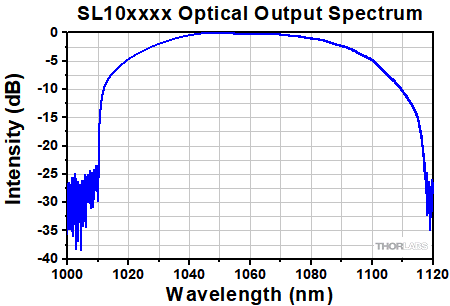
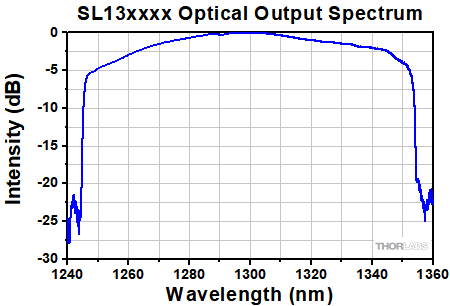
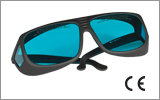
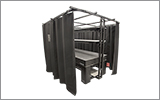
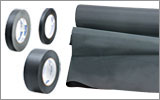
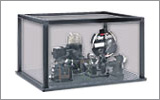
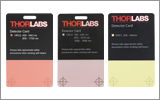
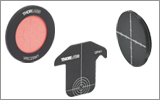
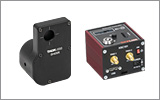
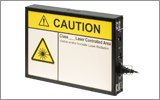
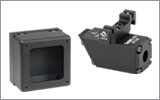
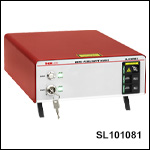
 Zoom
Zoom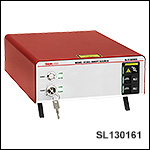
 MEMS-VCSEL Swept Sources
MEMS-VCSEL Swept Sources